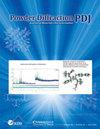Experimental evidence concerning the significant information depth of X-ray diffraction (XRD) in the Bragg-Brentano configuration
IF 0.4
4区 材料科学
Q4 MATERIALS SCIENCE, CHARACTERIZATION & TESTING
引用次数: 0
Abstract
X-ray diffraction in the Bragg-Brentano configuration (“XRD”) is a very established method. However, experimental evidence concerning its significant information depth, i.e. microstructure components from which maximum depth can affect the information evaluated from the acquired diffraction pattern, are scarce in the scientific literature. This depth is relevant to all XRD measurements performed on compact samples, especially layered composites and samples showing a crystallographic texture evolution. This article provides experimentally determined upper and lower limits to the significant information depth: XRD patterns acquired from a compact crystal layer through a layer of compact, amorphous glass indicate that the significant information depth of XRD using Cu Kα1 and Kα2 radiation is very likely larger than 48 μm, but smaller than 118 μm, in a material of the composition Mg2Al4Si5O18 with a density of ca. ~2.6 g/cm3. The depth of 48 μm correlates to the depth larger than the layer of material from which 90% of the reflected X-rays originate at 2Θ = 25.8°.Bragg-Brentano构型中X射线衍射(XRD)显著信息深度的实验证据
Bragg-Brentano构型中的X射线衍射(“XRD”)是一种非常成熟的方法。然而,关于其重要信息深度的实验证据,即最大深度可以影响从所获得的衍射图评估的信息的微观结构成分,在科学文献中很少。该深度与对致密样品进行的所有XRD测量有关,尤其是层状复合材料和显示结晶织构演变的样品。本文提供了实验确定的显著信息深度的上限和下限:从致密晶体层通过致密非晶玻璃层获得的XRD图谱表明,使用Cu Kα1和Kα2辐射的XRD的显著信息厚度很可能大于48μm,但小于118μm,在密度约为~2.6g/cm3的组成为Mg2Al4Si5O18的材料中。48μm的深度与大于材料层的深度相关,90%的反射X射线起源于2θ=25.8°的材料层。
本文章由计算机程序翻译,如有差异,请以英文原文为准。
求助全文
约1分钟内获得全文
求助全文
来源期刊

Powder Diffraction
工程技术-材料科学:表征与测试
CiteScore
0.90
自引率
0.00%
发文量
50
审稿时长
>12 weeks
期刊介绍:
Powder Diffraction is a quarterly journal publishing articles, both experimental and theoretical, on the use of powder diffraction and related techniques for the characterization of crystalline materials. It is published by Cambridge University Press (CUP) for the International Centre for Diffraction Data (ICDD).
 求助内容:
求助内容: 应助结果提醒方式:
应助结果提醒方式:


